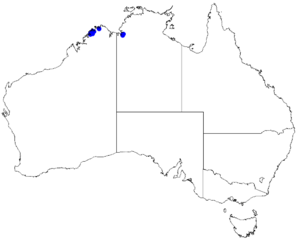Boronia filicifolia facts for kids
Quick facts for kids Boronia filicifolia |
|
|---|---|
| Conservation status | |
| Scientific classification | |
 |
|
| Occurrence data from Australasian Virtual Herbarium |
Boronia filicifolia is a beautiful shrub. It belongs to the citrus plant family, called Rutaceae. This plant is special because it only grows in a small area. You can find it in the far north-west of Australia. It can grow upright or spread out. This shrub has many branches. Its leaves are unique, looking a bit like ferns. They can have up to 55 small parts called leaflets. The flowers are white to pink. Their sepals and petals are about the same size.
What it Looks Like
Boronia filicifolia is a shrub that can stand tall or spread low. It usually grows up to 50 cm (20 in) high. Its leaves are called pinnate because they have many small parts. These parts are called leaflets. The whole leaf is usually 30–75 mm (1.2–3.0 in) long and 6–12 mm (0.24–0.47 in) wide. Each leaf has between 30 and 55 leaflets.
The leaflet at the very end of the leaf is shaped like a spear. It is about 3–8 mm (0.12–0.31 in) long and 1–5 mm (0.039–0.20 in) wide. The leaflets on the sides are a bit longer. They measure 0.5–5 mm (0.020–0.20 in) long and 0.5–3 mm (0.020–0.12 in) wide.
The flowers grow either alone or in small groups of up to three. They appear where the leaves meet the stem. Each flower has four sepals and four petals. Both are white to pink in color. They are also similar in length, about 2.5–3.5 mm (0.098–0.14 in) long. The sepals are 1.5–2 mm (0.059–0.079 in) wide. The petals are a little bit narrower. Inside the flower, there are eight stamens. These are the parts that produce pollen, and they are covered in tiny hairs.
Boronia filicifolia flowers from January to June. After flowering, it produces a fruit. This fruit is a smooth, dry seed pod called a capsule. It is about 5 mm (0.20 in) long and 2–2.5 mm (0.079–0.098 in) wide.
How it Got its Name
The plant Boronia filicifolia was first officially described in 1863. A botanist named George Bentham wrote about it. He used notes from another botanist, Allan Cunningham. Cunningham had collected a sample of the plant near York Sound. Bentham's description was published in a book called Flora Australiensis.
The name filicifolia comes from two Latin words. Filix means "a fern," and -folius means "leaved." So, filicifolia means "fern-leaved." This name perfectly describes its fern-like leaves!
Where it Lives
Boronia filicifolia is not a very common plant. It grows in special places. You can find it in areas with low, open shrubs called heathland. It also grows in open woodlands. These areas usually have rocky soil made of sandstone and quartzite.
This plant is found in the western part of the Kimberley region in Australia. Specifically, it grows near the Mitchell River and in the Port Warrender area.
Protecting the Plant
The government in Western Australia wants to protect Boronia filicifolia. The Western Australian Government Department of Parks and Wildlife has given it a special status. It is listed as "Priority Two."
This means that we don't know a lot about this plant. It has only been found in one or a few places. Because it's so rare and not well-known, it needs special attention to make sure it stays safe and doesn't disappear.


